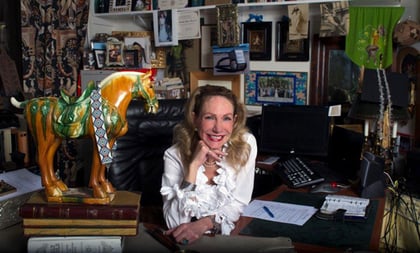Often overlooked in estate planning are baby boomers’ cherished porcelain dinnerware, crystal, sterling and robust antique furniture. News flash: Gen Xers and millennial children don’t want that dated stuff, which typically has low market value. But there are other ways to pass along families’ beloved decorative objects (and get tax deductions too), as certified appraiser Elizabeth Stewart, Ph.D., tells ThinkAdvisor in an interview.
Indeed, it is the objects’ economic value in the marketplace that the younger generations care about, not their sentimental value. So they have no yen to acquire fine formal china, embroidered tablecloths and Persian rugs for their homes. Instead, they crave the family stories behind such articles.
(See also: Warren Buffett’s 10 Nuggets of Investing Wisdom: Berkshire Letter 2018)
Therefore, clients should capture that history by recording videos inventorying the objects accompanied by audio relating the family history attached to them, Stewart advises. Even if offspring won’t appreciate owning the objects themselves, they’ll likely want videos representing them, she says.
Based in Santa Barbara, California, Stewart, a certified member of the Appraisers Association of America, is IRS-qualified to write noncash charitable appraisals. A consultant to estate and trust attorneys, financial advisors and firms such as U.S. Trust and Bessemer Trust, her new book is “No Thanks, Mom: The Top Ten Objects Your Kids Do Not Want (and what to do with them)” (Flandricka House Press 2017).
So how to divest heirlooms the younger generations take a pass on? Depending on the specific purpose in mind, parents can donate things with low market value to a range of different places. For example, give fine linens to a seamstress who makes wedding gowns and christening clothes. Otherwise, it’s sometimes possible to sell items like sterling flatware or fine dinnerware to replacement matching services.
Those family objects Gen Xers and Millennials do want are those with high market value, such as dual-purpose furniture and 1970s and 1980s nostalgia, like early video games and home computers. Think Atari game consoles and Commodore 64’s.
Stewart, an appraiser for 30 years and who has advised hundreds of baby boomers and their heirs, is a popular speaker at firms including Eaton Vance and Raymond James. For both, she has held private “Antique Roadshow”-style events and parties in which high-net-worth clients cart in their decorative objects for her to evaluate.
Two of her most challenging projects were advising Jonathan Winters’ heirs about the 160,000 objects the legendary comedian left upon his death in 2013 and helping a dot-com executive evaluate what came to 20 truckloads of groundbreaking computer animation software that he designed and donated to a university.
ThinkAdvisor recently interviewed Stewart, on the phone from Santa Barbara. The conversation turned to a chart she created, reproduced in her book, on “The Personality of the American Home”, which includes how the four current generations treat their possessions and living spaces. She found “Silent Generation” Moms (born:1928-1945) intent on doing their own housekeeping with Dad as the odd-jobber; baby boomers (1946-1964) putting housecleaning low on their agenda; Gen Xers (1965-1980) hiring housekeepers; and millennials (1981-1997) using floors as “catch-all” spaces. That is, they, um, do not comply with Ben Franklin’s proverb, “a place for everything and everything in its place.”
“Floors get used a lot more than furniture,” Stewart says.
Here are highlights from our conversation:
Parents asking adult children what cherished family objects they’d like to inherit and unloading those that they decline is a new idea, is it not?
Right. The tradition was, you read the will — and you get what you get.
What’s the top decorative object at which Gen Xers and Millennials turn up their noses?
Formal china because it can’t be microwaved or put in the dishwasher.
What objects do younger generations care about?
They’re most interested in the value of the objects in the marketplace. So you have to realize where the money comes from. The major money is in the Gen X and the millennial market. There’s more of them, and they have the most buying power of the four generations [others: traditionalists and baby boomers].
Doesn’t sentimental family value count?
Gen Xers and Millennials aren’t interested in sentimentality.
How do you help financial advisors help their clients?
We look at a client’s whole financial picture. People in financial houses usually look at just the dollars. We look at the whole collection of the household.
Why do you tell advisors to suggest that clients use digital technology to deal with heirship issues?
Because technology is the Gen Xer’s and millennial’s language. The client should [enlist] someone who knows how to video-record to follow them around their home and do an inventory to show the children. Not only is this valuable for the heirs, it’s valuable for insurance purposes.
Where does your input as an appraiser come in?
Some of the things kids don’t necessarily think much of would be valuable to them in the long run. So advisors often ask me, “What would you project? Will this artist or this Steuben crystal increase [in value]?” The answer is usually yes. When the advisors get a sense of the real value of objects over time, they can get the heirs interested in certain categories.
How can parents prevent offspring from fighting over objects?
In heirship appraisals about equitable distribution, I’ve seen siblings fight over an egg cup! In that sort of case, my suggestion is, again, do a video inventory of the objects, with the client telling the stories of objects: “This belonged to so and so. It’s important to me because…”









 March 21, 2018 at 03:04 PM
March 21, 2018 at 03:04 PM











